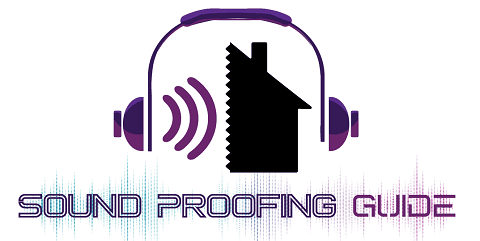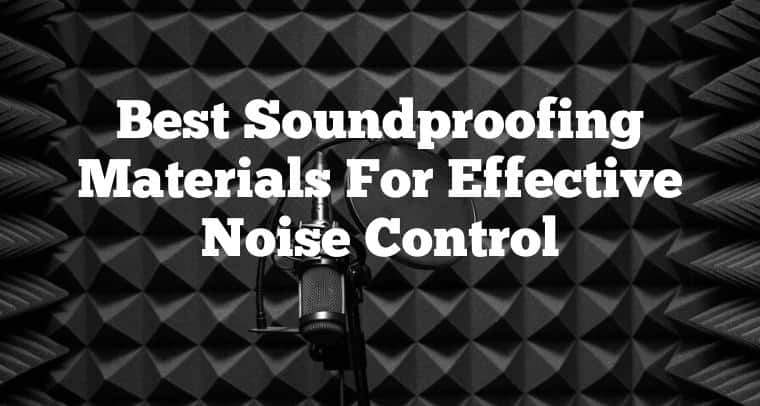Are unwanted noises from a neighbor or traffic annoying your peaceful life? Do you cherish a noise-free environment just like me, or you have a hobby or occupation which makes a lot of noise? If the answer to any above questions is “Yes” then you are at the right place.
If you are looking to soundproof your rooms, windows, doors, or air-vent, then choosing the right product is very important.
Nowadays, there are many products and materials in the market which claim to be soundproof. No doubt, many of them are quite useful, but some are questionable too. After making and correcting mistakes in construction and renovation for a long time, I have come up with the list of best soundproofing material that has worked for me.
In this article, I will be sharing affordable yet effective soundproofing materials and products that can help you save time and hard-earned bucks if you decide to soundproof your home, business, shop, or studio.
Before we jump right on to the main topic, let us take a minute to precisely understand the concept of soundproofing materials.
Page Contents
What is Soundproofing Material?
Any material that does not allow sound waves to pass through them, leading to sound insulation is known as a soundproofing material.
- Sound Absorbing Material: Which absorbs the sound waves, vibrations, and echoes present in a room, improving the acoustic of that room.
- Sound Reflecting Material: Materials that reflect the sound waves when they touch them, which in turn reduces noise.
Now, remember, it is not possible to achieve 100% sound insulation because it is not possible to make sure no sound wave gets through the materials. But if we use a combination of different materials and products in soundproofing any room, studio, doors, or windows, you will be satisfied with the result.
Identify the type of noises to be blocked.
When we start a Soundproofing project, it is essential to know what kind of sounds are we looking forward to blocking. This makes it easier for us to determine what soundproofing materials are suitable for our requirements.
- Airborne Sound: Sounds that are transmitted through the air. For instance, a distant construction work, passing by train, or someone playing music very loudly.
- On- Impact Sound: Sounds that are produced due to direct physical contact. For instance, someone hammering the other side of your wall or people stepping loudly on the ceiling above.
Things That Matter In SoudProofing Material
Let’s make things a lot simpler. We come across a lot of misinformation and false claiming products when it comes to soundproofing.
There are a few factors that are responsible for making a product soundproof, which you must consider while choosing a soundproof material. Not all noise-proof products and materials have all elements, but they must satisfy at least one.
Buying sound-absorbing products without knowing where you need what is going to be very tricky because they often come with specific uses in specific areas.
Mass of the Material
All materials & products that are thick and heavy are excellent sound insulators. It helps in blocking sounds, especially Airborne sounds.
So, if you have problems with sounds which are airborne such as loud voices and music, choosing materials that have high mass will be an excellent decision.
But if you are looking forward to blocking On- Impact sounds, going for heavy materials won’t do much good for your soundproofing project.
Dampening Capacity Of Materials
Sound dampening or sound damping is a method of dissipating vibrations before it becomes a noise. Sound dampening material converts sound energy into heat energy, making the sound stop all sudden.
They are excellent for blocking low-frequency sounds. One of the most efficient damping compounds is the green glue.
Decoupling Structures
When there is a massive structure, the sound produced by one part of the structure can vibrate through the whole structure and cause structure-based noise. To soundproof your space from structural resonances, decoupling is the best approach to take on.
Decoupling is creating gaps between walls, drywalls, edges, and ceilings, so that vibration in one part of the structure gets interrupted while travelling to another part due to the differences created.
Decoupling is excellent for low-frequency noises and on- Impact noises which create vibrations.
Sound Absorption Capacity Of The Material
Materials that absorb sound, as already discussed earlier, can and absorb the sound waves hitting them. Absorption helps to minimize the echos, sometimes even a low-frequency noise due to the reflection from different hard surfaces in the room cause amplify.
This works best when the materials are layered up to make sure that the material can absorb more amount of sound on the way itself.
You probably heard the music in the bathroom and a room, both have a different level of amplification in the sound, why? It’s because of the echos.
Things to Keep in Mind while going for a Soundproofing Material:
- Easy to work with the design.
- Consists of durable materials and not easy to fall apart.
- The thickness of the material.
- Helpful for air insulation as well if needed.
- Perfect fit for a specific job.
- Sufficient quantity is available.
- It gives value to your money.
Keeping in mind more than one of the above things while going for Soundproofing materials is going to increase the quality of your result.
12 Best Cheap Soundproofing Materials & DIY Ideas That Work
Most of these sound deadening products are readily available online, or at any brick & motor near you, for your convenience, I will add an amazon link so that you don’t end up buying the wrong material.
And remember, a combination of various soundproofing materials and products can and will help you with better sound insulation.
1. TMS Mass- Loaded Vinyl Sound Barrier
Mass loaded vinyl comprises dense, high-mass compounds like barium sulfate or calcium carbonate along with vinyl.
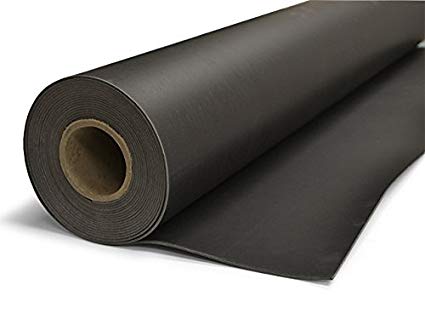 It is thin and flexible, but let you add mass wherever they are installed without adding extra bulk. It can be used on walls, ceilings, and floors cars, pipes, and even air ducts to block sound or instead reflect it.
It is thin and flexible, but let you add mass wherever they are installed without adding extra bulk. It can be used on walls, ceilings, and floors cars, pipes, and even air ducts to block sound or instead reflect it.
Installing MLV can guarantee you peace and quiet environment.
They are straightforward to install. All you have to do is cut it out according to the size of your need and then attach it using construction adhesive or hanging strips.
I will recommend you to double layer and ensure you apply it to the entire surface for maximum sound deadening.
2. Green Glue Soundproofing Compound
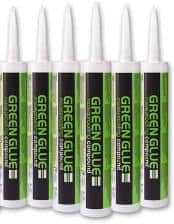 The green glue soundproofing compound is the most commonly used product in the construction of noise proofing homes. It is said to reduce the sound resonance factor as it is a dampening compound.
The green glue soundproofing compound is the most commonly used product in the construction of noise proofing homes. It is said to reduce the sound resonance factor as it is a dampening compound.
This compound works best when it is applied between two stiff panels, for example, between drywalls or plywood.
When the sound hits on one of the two layers, it causes vibration and friction with the compound, and the compound, in turn, converts the sound energy into heat energy, stopping the noise suddenly on its way.
It is effortless to use yet most effective and can also be used as a sealant for sealing holes, gaps in walls and ceilings, and much more to reduce sound leakage.
Pro Tip: It can be used to install other Soundproofing materials like acoustic foams, which can result in combined soundproofing.
3. Roberts Felt Cushion Roll Floor Underlayment
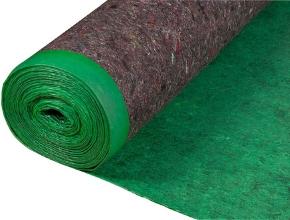 Floor underlayments are excellent for soundproofing floors, especially floors with laminates, hardwoods, and engineered floors.
Floor underlayments are excellent for soundproofing floors, especially floors with laminates, hardwoods, and engineered floors.
It comes with adhesive strips on one side, which you simply lay it down over the subfloor before final flooring. It locks vibrations which prevent the airborne as well as impact noises coming through the floor.
4. Rockwool Acoustic Mineral Wool Insulation
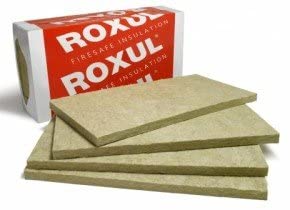 Acoustic mineral wool insulation is a rigid, fire-resistant, and is used for acoustic insulation, filtration, and thermal insulation. It is made up of molten mineral or rock material like slag or ceramic.
Acoustic mineral wool insulation is a rigid, fire-resistant, and is used for acoustic insulation, filtration, and thermal insulation. It is made up of molten mineral or rock material like slag or ceramic.
Mineral wool insulation is one of the best methods for sound insulating apartment walls and ceiling.
After installation, you can feel a significant reduction in outside noises and room echo. However, this stuff takes time, and it is not something you can do in one afternoon.
Construction material (Rockwool Acoustic Mineral Wool Insulation) meant to go inside of your walls. I will advise you to use this sound-insulating product only if you’re already renovating or are in a construction phase of your room.
5. Auralex RC8 Resilient Channel
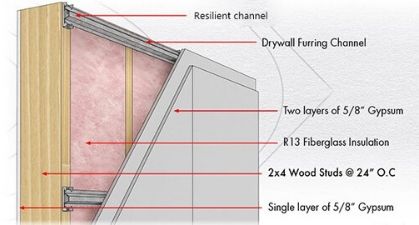 Resilient Channels are these pieces of metal channels that can be installed on the edges of your walls and ceilings to decouple the walls from the internal building structure and reduce the structural sounds due to vibration.
Resilient Channels are these pieces of metal channels that can be installed on the edges of your walls and ceilings to decouple the walls from the internal building structure and reduce the structural sounds due to vibration.
The usage of this material could be quite tricky, as these resilient channel needs to be placed in between two layers. You can set up a resilient sound channel, and only if you haven’t added layer of the drywall, otherwise drywall will first be needed to come off so that the resilient channel can be installed.
Once the resilient channels are in place, it is time to place the screws into the studs, which are the trickiest part because a little crack during the screwing can make the soundproofing DIY useless.
6. Sashco Big Stretch Acoustic Caulking Sealant
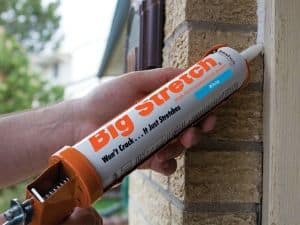 Usually, there are few crack and tiny holes around our apartment doors, windows, and even on edges of the drywall, which, if left unfilled, can waste all your soundproofing efforts. That’s where noise proofing caulking sealant comes in.
Usually, there are few crack and tiny holes around our apartment doors, windows, and even on edges of the drywall, which, if left unfilled, can waste all your soundproofing efforts. That’s where noise proofing caulking sealant comes in.
Acoustic sealants are used to seal all the cracks, gaps, and holes in your apartment so that no sound can pass through them.
Things you need:
- Acoustical caulk tube.
- Caulking gun to apply the sealant.
- A scraper to smoothen out the caulk.
Once you have the above three tools, you are good to start the sealing process.
7. Soundproof Drywall
Many people don’t even know that drywalls can be used for effective soundproofing walls and ceiling despite the prevalence of drywall in our everyday lives.
Soundproof drywall is different than regular drywall as it made by grinding the gypsum combining with layers of material like steel to increase its mass and density.
Although I am not a firm believer in drywall, although if you double it up and combine it with green glue, it will certainly block all incoming sounds.
8. Foamily Acoustic Foam Panels
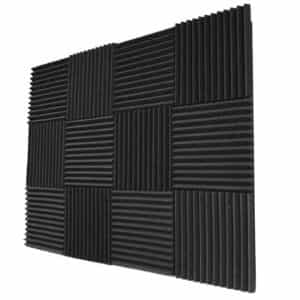 Acoustic foam panels is a sound-absorbing material, thereby not the best type of product for blocking the noise. However, they are effective in the absorption of soundwaves and reducing echos.
Acoustic foam panels is a sound-absorbing material, thereby not the best type of product for blocking the noise. However, they are effective in the absorption of soundwaves and reducing echos.
They are usually used in production studios or home theatres to reduce echoes and eliminate acoustic feedback. These panels are inexpensive, easy to hang & even easy to remove.
They come in various shapes, from egg crated to pyramid ones, from zig zag to simple lines. Thicker the acoustic panel is better it is in absorbing sound.
9. ATS Acoustic Panel
If you don’t wanna avoid the hassle of putting together and hanging unattractive foam panels then ATS acoustic panel is for you.
They are ready to use panels that reduce echoes, vibration and eliminates acoustic feedback and also look sophisticated when hanged on walls. It is made of a solid wood frame with a nice texture and would not shed, stink, or wear out easily.
These are excellent in deadening sound when you have a finished room and do not want to do any construction work. They are available in different colours & textures and will add up to your room décor.
10. Audimute Sound-Dampening Blanket
Now let’s discuss another sound-absorbing product which you might have seen in the studio before: soundproofing blankets.
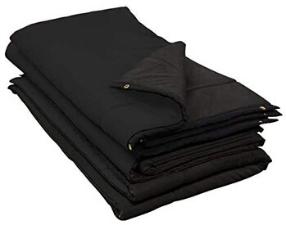 Soundproofing blankets are nothing but an enhanced version of moving blankets that help reduce noise where they are installed. It is thicker, denser, sturdier and heavier than moving blankets.
Soundproofing blankets are nothing but an enhanced version of moving blankets that help reduce noise where they are installed. It is thicker, denser, sturdier and heavier than moving blankets.
Audimute Sound-Dampening Blanket is not designed to block sound, but rather reduce echo and reverberations and improve sound quality in your space.
It can be used for soundproofing your studio rooms, study rooms, music rooms, or soundproofing a warehouse where you work. This product isn’t the most attractive option to use, as they don’t usually add up to the aesthetics of your room. However, if you are looking for a sturdy option, then this option is the one.
11. NICETOWN Noise Reducing Curtains
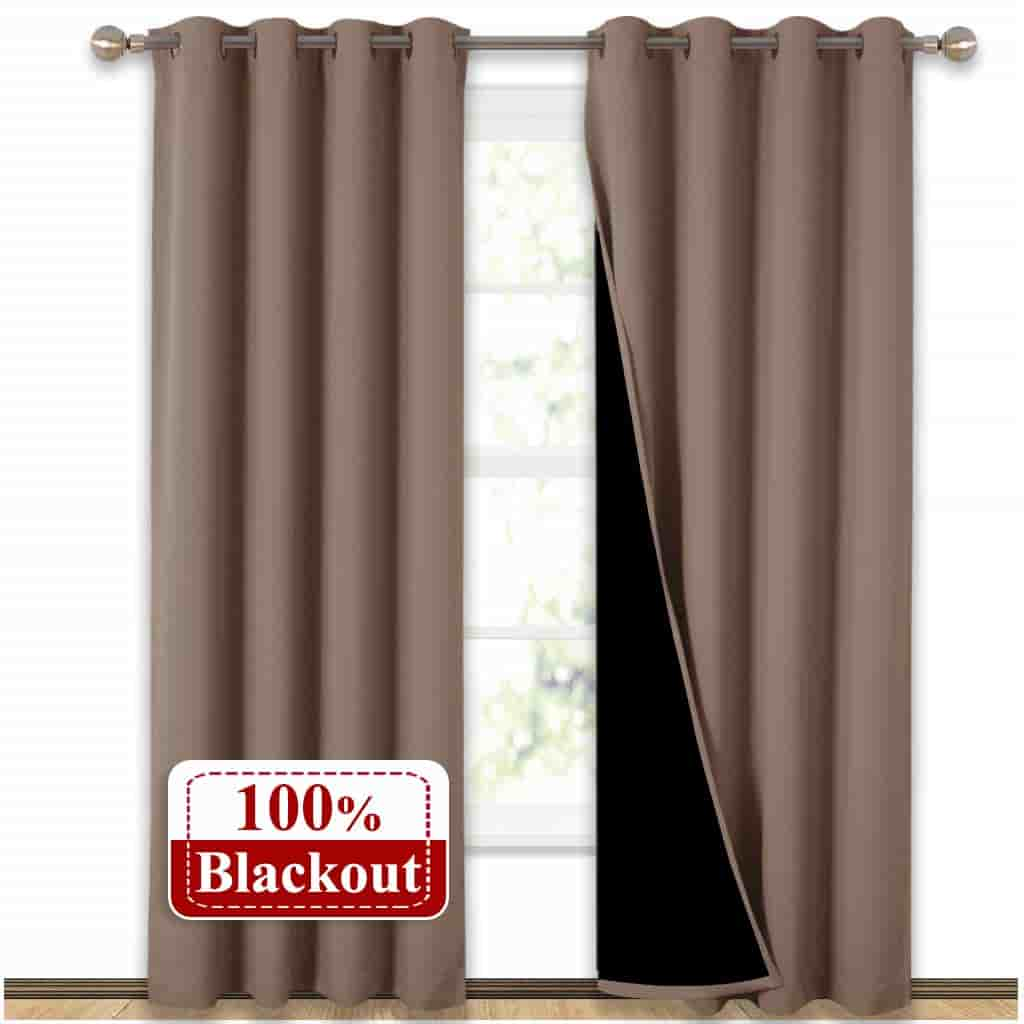 Soundproof curtains are the best way to eliminate echoes and reduce other unnecessary disruptive noises that come from both inside and outside your homes. They are not as effective as soundproof blankets but way better in aesthetic appeal.
Soundproof curtains are the best way to eliminate echoes and reduce other unnecessary disruptive noises that come from both inside and outside your homes. They are not as effective as soundproof blankets but way better in aesthetic appeal.
They might look similar to your ordinary curtains, but they are not the same. Sound-absorbing curtains are made of a thick and dense three layers of fabric that are stitched on top of each other.
Soundproof drapes do not cancel all noise, but they are a simple and effective choice to make the problem less.
12. Door & Window insulation weather strips
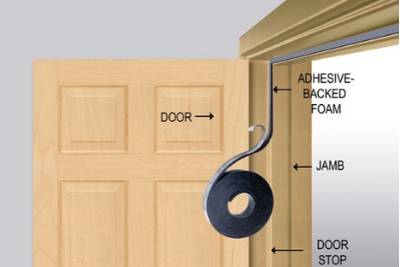 There are always small gaps and spaces in the edges of doors and windows through which sounds love to leak through, and these are the areas we often forget to soundproof.
There are always small gaps and spaces in the edges of doors and windows through which sounds love to leak through, and these are the areas we often forget to soundproof.
Soundproofing these areas play a crucial role in soundproofing your room. Compressible foam gasket helps to fill gaps on edges and thereby stopping unwanted noise.
Since it is self-adhesive, I would prefer keeping the surface it attaches to clean. This ensures that it stands no risk of getting detached once installed.
Don’ts while going for a Soundproofing Project
- Do not go for the cheapest material available in the market. Always go for the quality.
- Do not expect 100% success because sound waves are not natural to hinder.
- Do not use only one of the products while you are trying to make your space soundproofed. Using a combination of the above- mentioned products is going to give you the way more satisfying results.
- Do not apply too much pressure while installing the Resilient Channels because a small crack can make the whole soundproofing thing useless because a small crack is enough for sound waves to leak through.
- Do not go blindly to the market and buy random products. Know what you need and where you need it for and how much you need it beforehand so that when you go to buy your suitable soundproofing product, you do not get confused by the enormous amount of options available there.
- Do not cut or alter moving blankets or acoustic foams to fit the wall size. Instead, measure the size of the walls you need the product for so that you can go and ask for the exact size. Altering the product yourself can damage it.
Conclusion on soundproof materials and products.
Everyone has different sound-insulating requirements, and so the material and products to be chosen will differ with every project. However, as someone who has used and tried many soundproofing products and material at my home, I can assure you all of them mentioned above are best among there competitors.
I hope you enjoyed reading this article about the best soundproofing material and products and learned something out of it. I tried mentioning all materials for soundproofing you will ever need. However, I will suggest using a combination of multiple products as it will always give you better results.
